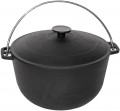Type
—
Gosling. There is also the name "duckling". Thick-walled dishes for stewing, originally used mainly for poultry (hence the name) — the shape and size of the goose are often designed so that the whole carcass can be placed inside. However, there are also exceptions to this rule. Also, of course, it can be used with other products — in particular, with some skill, ducklings can replace a cauldron (see below). As for the shape, it is usually either oval or rectangular — this is what the ducklings primarily differ from cauldrons. However, in this category there are also round dishes; in such cases, the differences are either in the material (the caterpillars are made of glass) or in the thickness of the walls (in metal caterpillars they are somewhat thinner than in cauldrons).
—
Kazan. Another kind of dishes for stewing and other "slow" cooking. It is worth noting that there are several varieties of cauldrons; in this case, products with a flat bottom are meant. In this case, the general shape of dishes may be different: some models taper downwards, others become cylindrical and resemble pots, and others are close in shape to hemispherical Tatar cauldrons (see below). However, we emphasize that anyway, a flat bottom is mandatory — and thanks to it, the cauldron can be securely installed on an ordinary stove and used effectively on it. Such dishes are considered perfect, first of all, for dishes of C
...entral Asian cuisine, such as pilaf and shurpa, although the variety of recipes for a cauldron is very large.
Tatar cauldron. This category includes cauldrons that have a classic hemispherical shape, without a flat bottom — this is their main difference from "ordinary" cauldrons (see above). This form is considered optimal, in particular, for cooking on a fire: in such cases, the hemisphere heats up as evenly as possible, providing a taste that is difficult to achieve in dishes with a flat bottom. It is this type of dishes, among other things, that is considered perfect for cooking pilaf and some other dishes of Central Asian cuisine. But for use on ordinary household stoves, Tatar cauldrons are poorly suited. So, on some types of burners it is simply impossible to stably install such a vessel; and where possible, the heating area is very small, and the cauldron actually turns into a wok (and using it in this role is much more difficult than a real wok). The situation with ovens is somewhat simpler, but goose casseroles and ordinary cauldrons with a flat bottom are better suited for such an application.Size
The main size of the dishes.
Most often, only one size is indicated here, but which one depends on the shape (see above). So, for round cauldrons, the diameter is given, and for oval and rectangular ducks — the length (the largest of the dimensions). Anyway, this indicator allows you to determine two points: firstly, how suitable is the container for “large-sized” ingredients (for example, a half carcass or a whole carcass of a bird); secondly, whether the dishes will fit on the stove, in the oven, microwave, etc. In addition, other dimensions may be indicated in the notes (for round dishes — height, for other shapes — length), which makes it even easier to estimate the capacity and space occupied.
As for specific values, a size
of up to 30 cm is considered small — however, in many cases this turns out to be quite enough, so a lot of such dishes are also produced.
31 – 35 cm can be called an average,
36 – 40 cm is above average, and in the most dimensional thick-walled household dishes, the size can
exceed 40 cm. It should be noted that the volume (see below) also depends on the width and height of the product, so there is no direct connection between the capacity and the claimed size: for example, dishes for 7-10 liters are found among all the categories mentioned above — from " up to 30 cm” to “more than 40 cm”. Thus
..., when choosing, it is worth not only taking into account the indicated size and volume, but also specifying specific dimensions.Volume
Nominal volume of dishes. Usually, it is indicated by the working volume — the actual amount of content that can fit inside without problems when used for its main purpose.
The main criterion for choosing this indicator is the volume of the planned cooking. So, dishes
up to 4 liters are intended mainly for small families of 2 – 3 people.
4-6 liter containers are already suitable for eating for 4-5 people. A capacity of
7 – 10 liters allows (especially in the case of ducklings) to fit inside a half carcass, or even a whole carcass of a bird. And the largest dishes will hold
more than 10 liters(in some cauldrons — up to 30 liters or more); such products may already come in handy at large family celebrations, mass events and in cafes / restaurants
Just in case, we recall that the reverse sides of a large volume are bulkiness, corresponding weight, as well as increased cost. In addition, for the effective use of such dishes, you need the appropriate space and equipment. Therefore, it is far from always that a larger volume is the best choice — it is worth considering the real needs and cooking conditions.
Also note that dishes similar in volume can have different shapes and proportions. For details on the form, see above; and proportions are associated with many nuances that determine the effectiveness of dishe
...s in a given situation. For example, a lower and wider cauldron will heat up more evenly when used on a kitchen burner, while a taller cauldron will work better in the oven. Detailed recommendations on this subject can be found in special sources.
